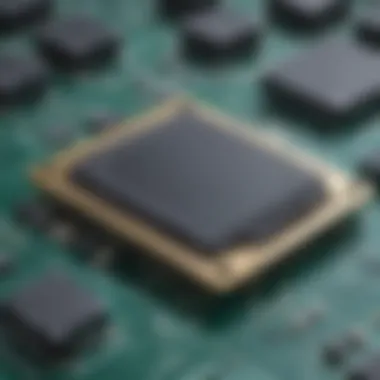Unleashing the Potential: The Power of Streamlined PCB Design Software


Software Overview
In the realm of PCB design, simplicity and efficiency are paramount to success. Introducing a seamless PCB design software tailored for small to medium-sized businesses, entrepreneurs, and IT professionals can significantly impact productivity and innovation in the technological landscape. This software aims to streamline the design process, offering an intuitive platform equipped with key features and functionalities to enhance the user experience.
User Experience
Navigating through the software's interface provides users with a user-friendly experience. The intuitive design and navigational elements ensure that users can swiftly adapt to the software, minimizing the learning curve typically associated with complex design tools. Customer support options are readily available, ensuring reliability and assistance whenever needed.
Performance and Reliability
Speed and efficiency are core aspects of the software's performance. By providing seamless operations and real-time updates, users can witness a notable increase in productivity. The software boasts impressive uptime statistics, minimizing downtime and optimizing workflow. Additionally, its integration capabilities with other tools enhance collaboration and workflow efficiency.
Security and Compliance
Data security is a top priority in the software. Robust data encryption and security protocols safeguard sensitive information, ensuring confidentiality and integrity. The software complies with industry regulations, providing users with peace of mind regarding data handling. Backup and disaster recovery measures are in place, guaranteeing data protection and continuity in the face of unforeseen events.
Introduction
In the intricate world of modern technology, the significance of simple PCB design software cannot be understated. The realm of PCB design plays a pivotal role in propelling technological advancements, serving as the foundation for a myriad of electronic devices. Designers constantly navigate through intricate processes and demanding challenges within the PCB design sphere. The quest for simplicity in software usability emerges as a crucial factor in enhancing operational efficiency and productivity for design teams.
Understanding the Need for Simple PCB Design Software
The role of PCB design in modern technology
The role of PCB design in modern technology encapsulates the essence of innovation and precision. It serves as the backbone of electronic developments, enabling the functionality of diverse gadgets and systems. The integration of PCB design into modern technology highlights its unparalleled contribution to the advancement of various industries.
Challenges faced by designers in the PCB design process
Designers encounter a multitude of challenges in the intricate PCB design process, ranging from component placement issues to signal integrity complications. The complexity of designs and the demand for high-speed connections pose continuous challenges for designers aiming for optimal performance and reliability.
The importance of simplicity in software usability
Simplicity in software usability stands as a crucial element in empowering design teams for seamless operations. The significance of intuitive interfaces and user-friendly functionalities cannot be overstated. Embracing simplicity enhances overall productivity and accelerates design processes through streamlined usability.
Overview of PCB Design Software
Traditional vs. modern PCB design software
A critical comparison between traditional and modern PCB design software reveals the evolution of design tools and methodologies. Modern software solutions emphasize flexibility and efficiency, contrasting with the rigid frameworks of traditional applications. This shift underscores the importance of adapting to cutting-edge technologies for enhanced design capabilities.
Key features to look for in PCB design software


Key features in PCB design software serve as the foundation for efficient design processes. From schematic capture capabilities to robust simulation tools, these features shape the usability and effectiveness of design software. Designers must prioritize software solutions that align with their specific requirements for optimal results.
The impact of software complexity on design efficiency
Software complexity directly influences design efficiency, with overly complex tools hampering productivity and innovation. Streamlining software interfaces and functionalities is essential for maximizing design efficiency and minimizing errors. Design teams must navigate the impact of software complexity to ensure smooth and productive design workflows.
Significance of User-Friendly Interfaces
Enhancing productivity through intuitive software design
Intuitive software design enhances productivity by simplifying complex processes and reducing cognitive load on designers. The seamless integration of tools and features within a user-friendly interface accelerates design tasks and promotes creativity within design teams.
Importance of ease of use for design teams
The importance of ease of use for design teams cannot be overstated in the context of PCB design software. User-friendly interfaces facilitate collaboration and communication among team members, fostering a conducive work environment for innovation and efficiency. Prioritizing ease of use enhances team collaboration and accelerates project timelines.
Case studies on the benefits of user-friendly interfaces
Real-world case studies attest to the transformative benefits of user-friendly interfaces in enhancing design workflows. By analyzing successful implementations of intuitive software interfaces, design teams can glean insights into best practices and strategies for optimizing productivity. These case studies underscore the tangible advantages of prioritizing user-friendly interfaces in PCB design software.
Key Features of Simple PCB Design Software
In the realm of PCB design, software plays a pivotal role in shaping the efficiency and effectiveness of the entire design process. Simple PCB design software stands out for its ability to streamline tasks, enhance workflow, and empower users with intuitive features. By focusing on the key elements of simple PCB design software, one gains a comprehensive understanding of how these tools can revolutionize the design landscape for small to medium-sized businesses, entrepreneurs, and IT professionals.
Intuitive Design Tools
Schematic capture capabilities
Schematic capture capabilities within PCB design software are crucial for translating conceptual designs into tangible layouts. This feature enables designers to graphically represent the connections between various components on a PCB, facilitating the visualization of the circuit's structure and functionality. The key advantage of schematic capture lies in its ability to simplify the complex process of circuit design, ultimately leading to faster development cycles and reduced design errors. Additionally, the intuitive nature of schematic capture tools enhances user productivity by offering a straightforward approach to designing intricate circuitry.
Layout editor functionalities
Layout editor functionalities are essential components of PCB design software that allow users to create physical representations of the circuit board layout. These tools enable designers to place components strategically, route connections efficiently, and ensure optimal placement for critical elements on the PCB. The key characteristic of layout editor functionalities is their user-friendly interface, which empowers users to visualize and optimize the board layout effectively. By leveraging layout editor tools, designers can expedite the layout design process, minimize routing errors, and achieve precise board designs with ease.
Simulation and analysis tools
Simulation and analysis tools embedded within PCB design software play a pivotal role in validating the functionality and performance of the designed circuits. These tools enable designers to simulate the behavior of the circuit under various conditions, identify potential issues, and optimize the design for enhanced performance. The unique feature of simulation and analysis tools lies in their ability to provide real-time feedback on the circuit's behavior, allowing designers to iteratively improve the design and mitigate any flaws. By utilizing simulation tools, designers can streamline the validation process, enhance design accuracy, and expedite the development of robust PCB designs.
The Benefits of Using Simple PCB Design Software
In today's fast-paced technological landscape, the demand for efficient and user-friendly PCB design software has reached unprecedented levels. This article delves into the significance of simple PCB design software for streamlining the design process, particularly for small to medium-sized businesses, entrepreneurs, and IT professionals. By exploring the key features and advantages of such software, readers will gain valuable insights into how it can revolutionize their approach to PCB design.


Enhanced Efficiency in Design Processes
Reduced Design Iterations
Reducing design iterations is a critical aspect of utilizing simple PCB design software effectively. This involves minimizing the number of design cycles required to achieve the desired outcome. By streamlining this process, designers can enhance their overall productivity and time-to-market for products. The key characteristic of reduced design iterations lies in its ability to optimize the design workflow, allowing for swift and efficient progress towards the final product. This aspect proves to be a popular and beneficial choice for businesses aiming for cost-effective and time-saving design solutions. The unique feature of reduced design iterations is its capacity to identify and rectify potential issues early in the design phase, thereby reducing the need for extensive revisions later on.
Faster Prototyping Cycles
Accelerating prototyping cycles plays a crucial role in expediting the product development process. Simple PCB design software facilitates faster prototyping by offering tools and functionalities that enhance the speed and accuracy of creating prototype designs. The key characteristic of faster prototyping cycles is their ability to reduce the time required to transition from design to physical prototype, enabling quicker validation of concepts and design ideas. This feature is a popular choice among businesses seeking rapid innovation and market responsiveness. The unique feature of faster prototyping cycles is their contribution to agile product development practices, ensuring efficient utilization of resources and streamlined design processes.
Minimized Errors and Rework
Minimizing errors and rework is fundamental to maintaining design quality and efficiency. Simple PCB design software aids in identifying and rectifying errors early in the design phase, thereby reducing the need for extensive rework. The key characteristic of minimizing errors and rework is its impact on design accuracy and reliability, leading to enhanced product quality and reduced time-to-market. This feature is a popular choice for businesses focusing on optimization and excellence in design outcomes. The unique feature of minimizing errors and rework is its ability to incorporate design validation tools that prevent costly mistakes and ensure consistent design performance.
Improved Collaboration and Team Productivity
Streamlined Communication Among Team Members
Efficient communication among team members is essential for successful collaboration in design projects. Simple PCB design software offers features that streamline communication by providing real-time collaboration tools and secure channels for exchanging ideas and feedback. The key characteristic of streamlined communication among team members is its facilitation of seamless information sharing and task coordination, enhancing overall team productivity and project outcomes. This aspect is a popular choice for businesses valuing effective teamwork and interdepartmental synergy. The unique feature of streamlined communication is its integration of communication tools within the design software, enabling instant feedback and decision-making for design teams.
Efficient Sharing of Design Files and Feedback
Facilitating the sharing of design files and feedback is crucial for maintaining transparent and constructive collaboration within design teams. Simple PCB design software enables efficient sharing through cloud integration and version control mechanisms that ensure secure and organized exchange of design assets. The key characteristic of efficient sharing of design files and feedback is its enhancement of collaboration efficiency and accuracy, allowing team members to access up-to-date information and provide timely feedback. This feature is a popular choice for businesses emphasizing effective information flow and collaboration in design projects. The unique feature of efficient sharing is its incorporation of customizable sharing settings and access controls, ensuring data security and streamlined feedback processes.
Enhanced Project Management Capabilities
Effective project management capabilities are vital for ensuring the success of design projects within set timelines and budgets. Simple PCB design software enhances project management through features that enable task assignment, progress tracking, and resource allocation for design teams. The key characteristic of enhanced project management capabilities is their contribution to project transparency and accountability, facilitating efficient decision-making and risk management. This aspect is a popular choice for businesses seeking structured and organized project workflows. The unique feature of enhanced project management capabilities is their integration with built-in reporting tools and analytics, providing insights into project performance and optimizing team productivity.
Cost-Efficiency and Time Savings
Reduction in Software Licensing Costs
Reducing software licensing costs is a significant benefit of utilizing simple PCB design software for businesses. This aspect involves minimizing the expenses associated with licensing fees for design software, leading to cost savings and resource optimization. The key characteristic of reduction in software licensing costs is its contribution to overall cost-efficiency and budget management, allowing businesses to allocate resources effectively towards other operational expenses. This feature is a popular choice among businesses looking to maximize their return on investment in design tools. The unique feature of this aspect lies in its scalability and flexibility, offering customizable licensing options tailored to the specific needs of different business sizes and project scopes.
Quicker Time-to-Market for Products
Accelerating time-to-market for products is a key advantage of leveraging simple PCB design software in design processes. This involves expediting the design and development phases to reduce the time required to introduce new products to the market. The key characteristic of quicker time-to-market is its impact on competitiveness and innovation, enabling businesses to respond rapidly to market demands and opportunities. This aspect is a popular choice for businesses operating in dynamic and competitive industries. The unique feature of quicker time-to-market is its alignment with agile product development methodologies, ensuring adaptability and responsiveness to changing market trends and customer preferences.
Optimized Resource Utilization
Optimizing resource utilization is essential for maintaining efficiency and sustainability in design projects. Simple PCB design software facilitates resource optimization by offering tools and features that streamline workflow and maximize the use of available resources. The key characteristic of optimized resource utilization is its ability to enhance productivity and output quality while minimizing waste and unnecessary expenses. This feature is a popular choice for businesses seeking lean and resource-effective design solutions. The unique feature of optimized resource utilization is its integration with performance tracking metrics and optimization algorithms that support data-driven decision-making and continuous improvement in design processes.


Case Studies on Simple PCB Design Software Implementation
In the intricacies of the PCB design realm, case studies play a pivotal role in elucidating the practical applications and benefits of leveraging simple PCB design software. These case studies offer invaluable insights into how businesses, particularly small to medium-sized enterprises, entrepreneurs, and IT professionals, can optimize their design processes through the adoption of user-friendly software solutions. By delving into real-world examples, readers can glean actionable strategies and foresight for enhancing their own design workflows.
Case Study 1: XYZ Electronics
Challenges Faced Prior to Implementing Simple PCB Design Software
XYZ Electronics, before integrating simple PCB design software, encountered multifaceted challenges that impeded their design efficiency and productivity. One notable challenge was the cumbersome nature of their previous software, which led to prolonged design cycles and hindered collaboration among team members. The lack of intuitive design tools further exacerbated these challenges, resulting in a bottleneck in their overall design process. Such impediments underscore the critical importance of transitioning to streamlined and user-friendly PCB design software.
Benefits Experienced Post-Implementation
Following the integration of simple PCB design software, XYZ Electronics witnessed a remarkable transformation in their design operations. The intuitive design tools offered by the new software facilitated a significant reduction in design iterations, culminating in faster prototyping cycles and a noteworthy decrease in errors and rework. Moreover, the streamlined collaboration options embedded in the software bolstered teamwork efficiency and communication, enhancing overall productivity within the design team.
Lessons Learned and Best Practices
Through the implementation process, XYZ Electronics gleaned valuable insights and best practices that are instrumental in maximizing the benefits of simple PCB design software. They learned the importance of conducting comprehensive training sessions for team members to expedite the software adoption process effectively. Additionally, establishing clear protocols for version control and seamless collaboration proved paramount in amplifying the advantages of the new software. These learnings serve as a testament to the iterative nature of software integration and the significance of continuous improvement strategies.
Case Study 2: ABC Robotics
Integration of Simple PCB Design Software into Existing Workflows
ABC Robotics undertook the integration of simple PCB design software into their existing workflows as a strategic move to optimize their design processes. This integration seamlessly harmonized with their established workflows, ensuring a smooth transition without disruption to ongoing projects. By incorporating user-friendly software into their operations, ABC Robotics unlocked a new realm of design flexibility and efficiency, elevating their competitive edge in the market.
Measurable Improvements in Design Efficiency
The implementation of simple PCB design software at ABC Robotics yielded tangible enhancements in design efficiency, as evidenced by a significant reduction in design turnaround times and prototyping phases. The software's intuitive features enabled the design team to iterate rapidly, resulting in accelerated product development cycles and heightened design accuracy. These measurable improvements underscore the transformative potential of embracing simplicity in PCB design processes.
Impact on Overall Business Operations
The impact of simple PCB design software on ABC Robotics' overall business operations was profound, extending beyond design efficiency to encompass organizational dynamics. The enhanced collaboration facilitated by the software fostered a culture of innovation and knowledge sharing within the company, propelling them towards greater operational agility. Furthermore, the software's cost-efficiency and time-saving attributes translated into optimized resource allocation and enhanced project management capabilities, underscoring its pervasive impact on ABC Robotics' bottom line.
Conclusion
Embracing Simplicity in PCB Design
The Future of PCB Design Software
Delving into the future of PCB design software unveils a landscape shaped by innovation and functionality. The evolution of design tools signifies a shift towards more intuitive, versatile, and interconnected platforms, designed to cater to the evolving needs of designers and engineers. Enhanced automation, integration, and scalability stand out as fundamental aspects driving the future of PCB design software, ensuring seamless workflows and heightened design accuracy. The emphasis lies on real-time collaboration, cloud-based solutions, and adaptive interfaces that transcend traditional limitations, catapulting design processes to new heights of efficiency and precision.
Recommendations for Businesses Seeking User-Friendly Solutions
For businesses in pursuit of user-friendly PCB design solutions, key considerations must revolve around scalability, compatibility, and support. Opting for software with robust collaboration tools, flexible licensing models, and extensive customer support can significantly enhance the design journey. Tailored recommendations include exploring software vendors with a proven track record in offering intuitive interfaces, comprehensive training resources, and bespoke customization options to meet specific organizational requirements. By aligning with user-friendly solutions, businesses can unlock a plethora of benefits, including accelerated time-to-market, minimized design complexities, and optimized resource allocation.
Final Thoughts on the Importance of Simplicity in Design Tools
As we reflect on the importance of simplicity in design tools, it becomes evident that clarity and efficiency are paramount in achieving design excellence. Simple, yet powerful software equips designers with the tools needed to translate creative visions into tangible results seamlessly. The core essence of simplicity lies in fostering creativity, collaboration, and innovation, propelling businesses towards sustainable growth and technological advancement. By embracing simplicity in design tools, organizations set a solid foundation for success in the dynamic landscape of PCB design, heralding a new era of efficiency, precision, and ingenuity.







